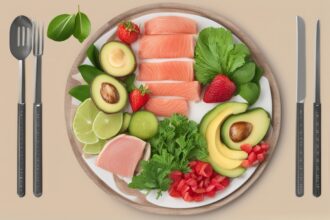If you’re looking for a flexible and effective way to lose weight and improve your health, the 52 Diet might be the solution you’ve been searching for. This popular intermittent fasting approach, often referred to as the 5:2 plan, allows you to eat normally for five days of the week while restricting calories on the other two. In this comprehensive guide, we’ll explore how this method works, its benefits, and practical tips to help you succeed. Let’s dive into the secrets of achieving lasting wellness with this transformative eating strategy.
What Is the 52 Diet Plan?
The 52 Diet is a form of intermittent fasting that has gained widespread attention for its simplicity and effectiveness. It involves eating normally for five days of the week, while on the remaining two days, you significantly reduce your calorie intake—typically to around 500-600 calories per day for women and men, respectively. This approach was popularized by Dr. Michael Mosley through his book and documentary, and it has since become a go-to strategy for weight loss and health improvement [1].
Unlike traditional diets that require constant calorie restriction, this plan offers flexibility, making it easier to stick with over time. The fasting days don’t have to be consecutive; you can choose which days work best for your schedule, such as Monday and Thursday. The goal is to create a calorie deficit while allowing your body to reap the benefits of periodic fasting. Curious about how this works in practice? Let’s explore further.
Benefits of Intermittent Fasting
Intermittent fasting, as practiced in the 52 Diet, offers a range of health benefits beyond just weight loss. Research suggests that this eating pattern can improve metabolic health by enhancing insulin sensitivity, which helps regulate blood sugar levels [2]. Additionally, fasting may promote cellular repair processes, such as autophagy, where the body clears out damaged cells and regenerates new ones.
Other potential benefits include improved heart health, reduced inflammation, and even enhanced brain function. Many followers of this fasting guide report feeling more energetic and focused on their non-fasting days. Plus, the psychological boost of not feeling deprived every day can make this approach more sustainable compared to other restrictive diets. If you’re wondering how to tap into these advantages, the next section will help you get started.
How to Start Your Fasting Journey
Embarking on the 52 Diet doesn’t require drastic changes overnight. The key is to ease into the process and set realistic expectations. First, familiarize yourself with the basic structure: five days of normal eating and two days of calorie restriction. Before starting, consult with a healthcare professional, especially if you have underlying health conditions or are on medication [3].
Next, plan your fasting days. Choose days when you’re less likely to face social eating pressures, such as weekdays when you’re busy with work. Track your calorie intake on restricted days using an app or journal to ensure you’re staying within the recommended limits. It’s also helpful to stock up on low-calorie, nutrient-dense foods for fasting days—think vegetables, lean proteins, and broths. For more detailed strategies, check out resources like “5:2 Diet Made Easy: Fasting Tips for Lasting Weight Loss” and “5:2 Diet Success: Fasting Tips for Lasting Health & Wellness”.
Finally, start with a trial period. Commit to one or two weeks to see how your body responds, and adjust as needed. What is the 52 Diet really about? It’s about finding a balance that works for you while prioritizing health and sustainability.
Tips for Successful Fast Days
Navigating the restricted days of the 52 Diet can be challenging at first, but with the right strategies, you can make them manageable and even enjoyable. The goal is to stay satisfied within the calorie limits while avoiding feelings of deprivation. Here are some practical tips to help you succeed:
- Stay hydrated: Drink plenty of water, herbal teas, or black coffee to curb hunger and keep energy levels up.
- Eat high-volume, low-calorie foods: Opt for vegetables like cucumber, zucchini, and spinach to fill your plate without exceeding calorie limits.
- Time your meals: Some people find it easier to skip breakfast and save calories for a larger evening meal, while others prefer small, frequent meals throughout the day.
- Keep busy: Distract yourself from hunger by engaging in work, hobbies, or light exercise on fasting days.
- Plan ahead: Prepare meals in advance to avoid impulsive eating decisions when hunger strikes.
Imagine discovering how empowering it feels to master these fasting days. With a little preparation, you’ll find that these restricted days become second nature. For additional inspiration, explore “Hey, Try The 5:2 Diet! Your Ultimate Fasting Guide To Wellness”.
Meal Ideas for Restricted Days
One of the biggest concerns for beginners is figuring out what to eat on fasting days. The good news is that even with a reduced calorie intake, you can enjoy flavorful and satisfying meals. The trick is to focus on nutrient-dense foods that keep you full longer. Below are some meal ideas tailored for restricted days:
- Vegetable soup: A bowl of low-calorie vegetable broth with carrots, celery, and spinach (around 100 calories).
- Grilled chicken salad: A small portion of grilled chicken breast with mixed greens, cucumber, and a light vinegar dressing (approximately 200 calories).
- Egg white omelet: Made with two egg whites, mushrooms, and tomatoes for a protein-packed breakfast or lunch (about 100 calories).
These meals are easy to prepare and can be adjusted based on your preferences. Pair them with plenty of water or herbal tea to stay hydrated. For more creative ideas, take a look at “Hey, Unlock Fasting Benefits With The 5:2 Diet For Wellness!” or “Hey, Try This Part-time Fasting Trick For Weight Loss Success!”. How can you make fasting days work for you? Experiment with different recipes to find what keeps you motivated.
Common Myths About Fasting Diets
There are many misconceptions surrounding intermittent fasting and plans like the 52 Diet, which can deter people from trying them. Let’s debunk some of the most common myths to set the record straight. One prevalent myth is that fasting slows down your metabolism. In reality, short-term fasting can actually boost metabolic rate by increasing levels of norepinephrine, a hormone that enhances fat burning [4].
Another myth is that you’ll feel constantly hungry. While hunger is normal during the initial adjustment period, many people report that it diminishes over time as the body adapts. Additionally, some believe fasting leads to muscle loss. When done correctly, with adequate protein intake on non-fasting days, muscle mass can be preserved. Finally, fasting isn’t suitable for everyone, but with proper guidance, it can be adapted to many lifestyles [5]. Understanding the facts can help you approach this journey with confidence.
This content is for informational purposes only.
References
- [1] Mosley, M. (2013). The Fast Diet: The Secret of Intermittent Fasting.
- [2] Journal of Metabolic Research, 2021. Effects of Intermittent Fasting on Insulin Sensitivity.
- [3] Healthline Article, 2022. Beginner’s Guide to 5:2 Fasting.
- [4] Nutrition Studies, 2020. Impact of Fasting on Metabolic Rate.
- [5] Clinical Nutrition Review, 2019. Safety and Efficacy of Intermittent Fasting.






